Grading Guide for the Vn Decimo of 1930-1947
Determinación del Grado de Conservación
The following is a grading guide for the
Vn Decimo coin of 1930-1947.
It is based on the Sheldon grading scale of 1-70 which is widely used in the
United States and elsewhere including Panama.
Grading is an art, and is subjective in nature. Different collectors and dealers
will have legitimately different opinions about the same coin. However,
there are generally recognized standards used as a basis for grading coins, medals
and tokens. Standards have been published for grading Panama coins by the Isthmian
Numismatic Society (now defunct) and the Asociación Numismática De Panamá (in Spanish).
The guide below is my application of the Sheldon grading scale
to the Vn Decimo coin of 1930-1947, taking into account the standards previously
published.
Quick Hints for Grading the Vn Decimo of 1930-1947
On eBay or looking at a coin dealer's stock, you may want to quickly and easily grade
this coin. Here are some quick hints.
- If the helmet on the
obverse merges into the face, the Vn Decimo is low grade, Good or About Good.
- If the flat spots on the eagle's breast and leg or legs have merged, the Vn Decimo is
a Fine or lower grade.
- Count the rivits on Balboa's helmet that are visible. Four rivits is Very Good,
five rivits but one faint is Fine, five clear rivits is Very Fine, six distinct rivits
is Extra Fine or better.
- For potential UNC or AU coins, look at the middle of the helmet on the obverse for
evidence of friction, and the breast of the eagle on the reverse for a flat spot.
Poor (P-1)
Sometimes referred to as the "basil state". This is an object that
is barely recognizable as having been a silver Un Decimo from Panama,
or perhaps the similar Cinco Centésimos of 1904 and 1916. The design is
almost completely gone due to wear or corrosion and date is illegible.
This coin has no numismatic value, it is time to melt it down!
Fair (Fa-2)
Extremely heavy wear or damage. However, the coin is recognizable as to type
and date. The date can be severely worn or damaged, including missing digits,
but it must be recognizable.
Except for rare dates, this coin has no numismatic value.
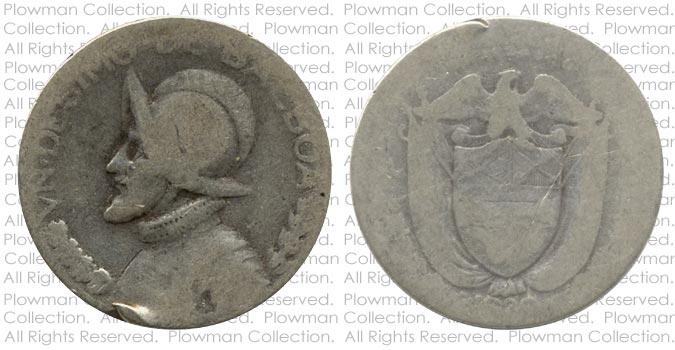
Example of a Vn Decimo in Fair (Fa-2) Condition
The above example is heavily worn. The rims are worn away and major portions
of the legends are gone. Designs are flat without much if any detail. The only
parts not flat are damage marks. On the obverse, Balboa is recognizable but flat,
and enough is left of the legend to be legible, On the reverse, the coat of arms
of Panama is recognizable but very flat. The legends are all gone except the
top of the date. However enough is left
of the date to recognize that this is a 1930.
So I would grade this coin as a Fair (Fa-2).
About Good (AG-3)
Very heavily worn with portions of the lettering, date and legends worn smooth.
OBVERSE: Balboa is outlined with nearly all details worn away. Legend is merging
into the rim.
REVERSE: Coat of Arms, flags and eagle are outlined but flat with nearly all details
worn away. Legend is merging into the rim. Date is readable but worn.
The rim is worn, and the design is very flat. Severe and numerous marks are allowed.
This low grade has no numismatic value, only precious metal (silver) value.
Good (G-4)
Heavily worn. Major designs visible but flat and may be faint in areas. The
peripheral lettering should be mostly full, and most legends should be visible.
The rim or edge should be mostly intact, but worn edges are allowed.
Numerous marks are allowed but should not be so
severe that a major design feature is unrecognizable.
This low grade has little numismatic value, but certainly has precious metal (silver) value.
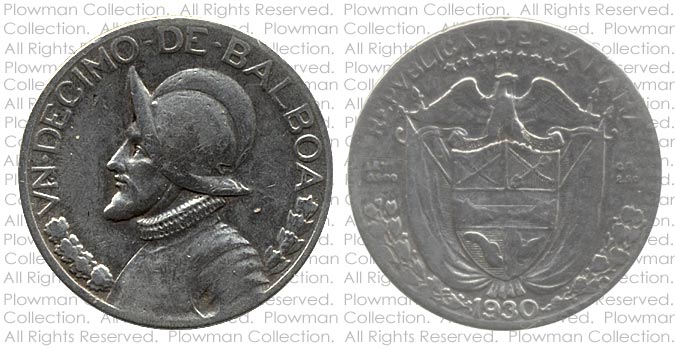
Example One of a Vn Decimo in Good (G-4) Condition
The obverse of the above example has four rivits visible, although the helmet design
is gone. The rims are showing wear, especially above the "DE" but all letters are full. The
reverse however has significantly worn rims with the tops of the letters of "REPVBLICA
DE PANAMA" starting to wear away, although the date has full numbers. The coat of arms
is flat and eagle are flat, with many design elements outlined but lacking in detail.
The wear on the reverse being worse than the obverse is typical of this type, perhaps
due to the relative height of the rims or just overall design. I would grade this coin
as a Good (G-4).
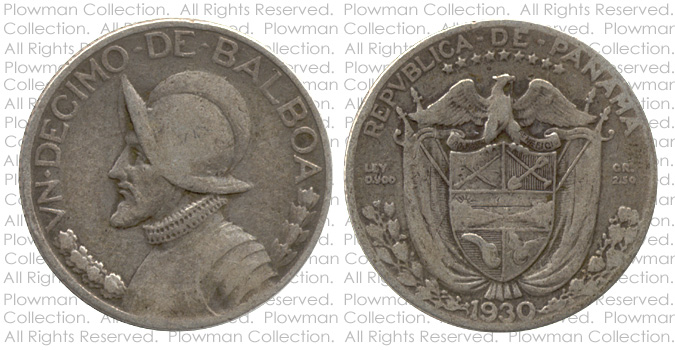
Example Two of a Vn Decimo in Good (G-4) Condition
The obverse of the above example has only three rivits visible. The helmet design
is gone, and the helmet and face are starting to merge. The rim on the obverse is showing
wear, especially under the bust of Balboa. On the reverse, the rim is weak and starting to
merge with the peripheral letters and numbers at several places. The coat of arms
and eagle are flat, with many design elements outlined but lacking in detail.
I would grade this coin as a Good (G-4).
Very Good (VG-8)
Well worn. Bold major designs but absence of fine details. Edges and rims
should be intact. The peripheral lettering should be full.
OBVERSE: Part of the helmet design is still visible, and four of the rivits.
REVERSE: Parts of the motto "PRO MUNDI BENEFICIO" have disappeared.
Some marks are allowed but should not be too severe.
This low grade has little numismatic value, but certainly has precious metal (silver) value.
Fine (F-12)
Moderate but even wear. Bold entire design but with some weaknesses. Deep
recessed areas should retain their detail. About 50% of all the fine detail should
be present.
OBVERSE: Wear shows on the beard and cheek of Balboa. Five rivits are still visible
on the helmet although one or two may be faint.
REVERSE: Wear shows on the head and wings of the eagle. Motto "PRO MUNDI BENEFICIO"
is still completely legible but faint.
Some marks are allowed but should not be very deep, long, or distracting.
Many un decimo coins are in this state. They have some numismatic value, and
are generally the minimum grade that collectors prefer to have in their collection.
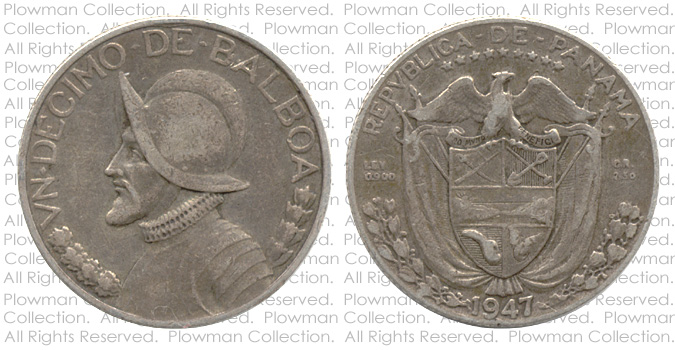
Example of a Vn Decimo in Fine (F-12) Condition
The above example has five clearly visible rivits. The middle rivit is gone or very faint.
The helmet details are very faint. The rims and letters are still full and strong on the
obverse. Wear shows on the cheek and beard of Balboa. On the reverse,
the are flat spots on the breast and legs of the eagle have merged. Significant wear spots
appear on the cornucopia, wing tips, top of the outer flag poles and some leaves in the wreaths.
The letters "PR", "I", "B" and "O" in the motto "PRO MUNDI BENEFICIO" are weak or faint.
Otherwise the rims and legends are intact, as well as about 50% of the fine detail.
This is still an attractive coin which I would grade as a Fine (F-12).
Very Fine (VF-20, VF-30)
Generally light wear, moderate wear at high points. All major features must be
present and clear. About 75% of all the fine detail should
be present.
OBVERSE: At least five rivits are clearly visible on the helmet (without magnification).
Helmet detail is faint but visible.
REVERSE: Flat spots show wear on eagle, especially on the breast and legs, but these flat
spots do not merge together. Slight wear
shows on the head and wings of the eagle. The fruits and vegetables from the cornucopia
are worn flat.
Overall it should be an attractive coin.
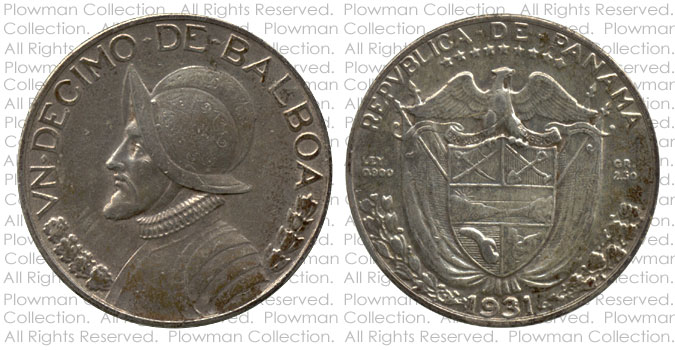
Example of a Vn Decimo in Very Fine (VF-20) Condition
The above example has five clearly visible rivits. The middle rivit is gone, at least
without magnification. The helmet details still appear but are faint. On the reverse,
there are flat spots on the breast and legs of the eagle, and on the cornucopia (all the
fruits and vegetables have merged into one flat spot). Otherwise
this is an attractive coin which I would grade as a Very Fine (VF-20).
Extra Fine (EF-40, EF-45)
Light overall wear on the highest points. Most of the devices on the
coin are sharp, clearly defined. About 90% of all the fine detail
should be present.
OBVERSE: All six rivits are distinctly visible on the helmet. Slight wear on the middle of
the helmet.
REVERSE: Slight wear shows on the breast of eagle, and traces of wear on the eagle's
head and eagle's right leg (our left). There are also slight traces of wear on the
"PRO MUNDI BENEFICIO" motto, stars and lines of drapery. The cornucopia retains
about 50% of the fine detail.
Traces of luster may show. Overall it should be an attractive coin.
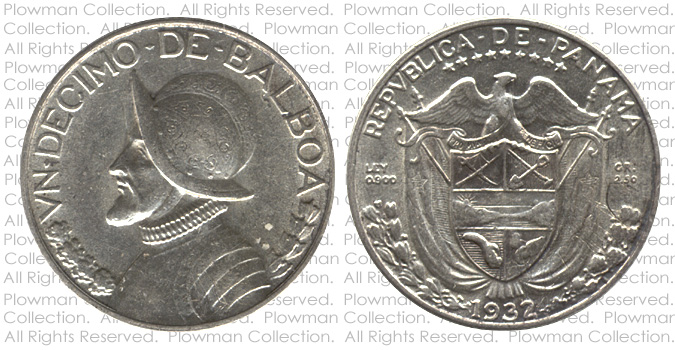
Example of a Vn Decimo in Very Fine (EF-40) Condition
The above example has six clearly visible rivits. There is some wear in the middle of
the helmet, but the helmet still retains lots of detail. On the reverse,
there is a medium-size flat spot on the eagle's breast. The eagle's right leg shows a
small flat spot as does the eagle's head. The cornucopia has lost some detail but does
retain some detail. Overall
this is an attractive coin which I would grade as Extra Fine (EF-40).
About Uncirculated (AU-50, AU-55, AU-58)
Traces of wear or friction on the highest points. At least 50% of
the original mint luster should be present. The details and lettering
on the coin are very sharp and clearly defined.
OBVERSE: May have slight wear on the middle of the helmet.
REVERSE: May have slight wear (a small flat spot) on breast of eagle. There is no
apparent wear on the "PRO MUNDI BENEFICIO" motto, stars and lines of drapery.
Overall it should be a very attractive coin. A novice may describe it as "shiny"
and "new", and be unable to distinguish it from an uncirculated coin.
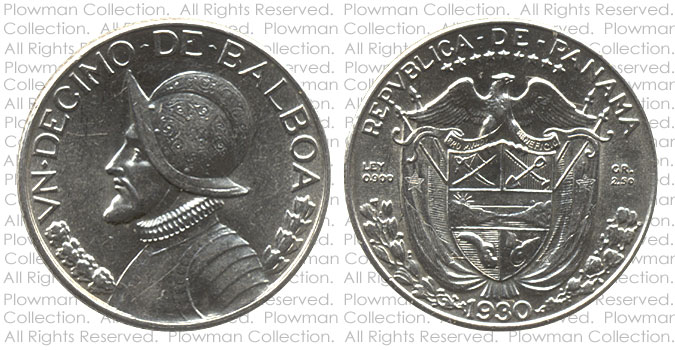
Example of a Vn Decimo in About Uncirculated (AU-50) Condition
Overall the above coin is very attractive with nice color and excellent detail. If you
look closely however, you will note traces of friction on the middle of the helmet.
On the reverse, although no other wear can be seen, there is a small flat spot on the
eagle's breast. I would grade this coin as About Uncirculated (AU-50).
Uncirculated (MS-60)
No trace of wear whatsoever. Original mint luster fully present, but
can be poor and unattractive. Numerous marks are allowed, but not so
many that the coins could be considered damaged. Overall this coin
is not attractive and has poor eye appeal.
Choice Uncirculated (MS-63)
No trace of wear whatsoever. A nice uncirculated coin which is attractive and has
positive eye appeal. There may
be numerous marks or hairlines, including several major marks in the main focal areas. If
there are distracting marks or hairlines on the major devices, then the fields should be
relatively clean. If there are distracting marks or hairlines in the fields, then the devices
should have less disturbance. The strike will range from about average to full.
The luster will range from about average to full.
There can be noticeable spotting, including several large spots or a group of small ones.
Overall this is an attractive coin with some minor distractions.
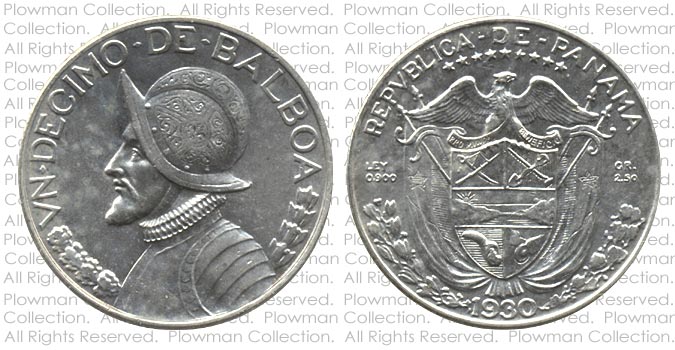
Example of a Vn Decimo in Choice Uncirculated (MS-63) Condition
This coin shows no signs of circulation, no trace of wear on either side. It has
below average luster but very few marks and no hairlines. The appearance on the obverse
especially on the left is marred by cloudy areas in the field. There are two small nicks on
Balboa's sleeve. The reverse has cloudy areas in the field on either side of the coat of arms.
Overall I would grade this coin as a Choice Uncirculated (MS-63).
Gem Uncirculated (MS-65)
No trace of wear whatsoever. Blazing original luster and virtually no surface flaws.
A coin may grade MS-65 with scattered light marks, but with great luster and strike -
or a coin with virtually no marks but slightly impeded luster also could be MS-65.
The overall eye appeal must be very positive. There may be several scattered marks,
hairlines, or other minor defects. If the flaws are in a main focal area, then they must
be minor and fewer. Hidden marks and hairlines can be larger. The coin must be well-struck.
The luster must be above average, and any toning can only slightly impede the luster.
Overall this is a very attractive coin with nothing to detract from the eye appeal.
|







